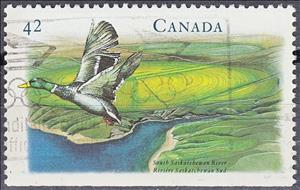Stamp: South Saskatchewan River (Canada 1992)
South Saskatchewan River (Canada 1992)
22 April (Canada ) within release Canadian Rivers (2nd series), Waterways of Industry & Commer goes into circulation Stamp South Saskatchewan River face value 42 Canadian cent
| Stamp South Saskatchewan River in catalogues | |
|---|---|
| Michel: | Mi:CA 1287Du |
| Stamp Number: | Sn:CA 1412  |
Stamp is horizontal format.
Fluorescent frame. Single with straight edge at top or bottom from booklet pane (1412b) (BK145)Also in the issue Canadian Rivers (2nd series), Waterways of Industry & Commer:
- Booklet Pane - Heritage Rivers - 2 face value 10*42;
- Stamp - Margaree River face value 42;
- Stamp - West (Eliot) River face value 42;
- Stamp - Ottawa River face value 42;
- Stamp - Niagara River face value 42;
- Stamp - South Saskatchewan River face value 42;
- Booklet - Heritage Rivers-Waterways of Industry & Commerce face value 10*42;
Stamp South Saskatchewan River it reflects the thematic directions:
Animals are multicellular, eukaryotic organisms of the kingdom Animalia (also called Metazoa). All animals are motile, meaning they can move spontaneously and independently, at some point in their lives. Their body plan eventually becomes fixed as they develop, although some undergo a process of metamorphosis later on in their lives. All animals are heterotrophs: they must ingest other organisms or their products for sustenance.
Birds (Aves), a subgroup of Reptiles, are the last living examples of Dinosaurs. They are a group of endothermic vertebrates, characterised by feathers, toothless beaked jaws, the laying of hard-shelled eggs, a high metabolic rate, a four-chambered heart, and a strong yet lightweight skeleton. Birds live worldwide and range in size from the 5 cm (2 in) bee hummingbird to the 2.75 m (9 ft) ostrich. They rank as the class of tetrapods with the most living species, at approximately ten thousand, with more than half of these being passerines, sometimes known as perching birds. Birds are the closest living relatives of crocodilians.
A landscape is the visible features of an area of land, its landforms and how they integrate with natural or man-made features. A landscape includes the physical elements of geophysically defined landforms such as (ice-capped) mountains, hills, water bodies such as rivers, lakes, ponds and the sea, living elements of land cover including indigenous vegetation, human elements including different forms of land use, buildings and structures, and transitory elements such as lighting and weather conditions. Combining both their physical origins and the cultural overlay of human presence, often created over millennia, landscapes reflect a living synthesis of people and place that is vital to local and national identity. The character of a landscape helps define the self-image of the people who inhabit it and a sense of place that differentiates one region from other regions. It is the dynamic backdrop to people’s lives. Landscape can be as varied as farmland, a landscape park, or wilderness. The earth has a vast range of landscapes, including the icy landscapes of polar regions, mountainous landscapes, vast arid desert landscapes, islands and coastal landscapes, densely forested or wooded landscapes including past boreal forests and tropical rainforests, and agricultural landscapes of temperate and tropical regions.
A river is a natural freshwater stream that flows on land or inside caves towards another body of water at a lower elevation, such as an ocean, lake, or another river. A river may run dry before reaching the end of its course if it runs out of water, or only flow during certain seasons. Rivers are regulated by the water cycle, the processes by which water moves around the Earth. Water first enters rivers through precipitation, whether from rainfall, the runoff of water down a slope, the melting of glaciers or snow, or seepage from aquifers beneath the surface of the Earth.




